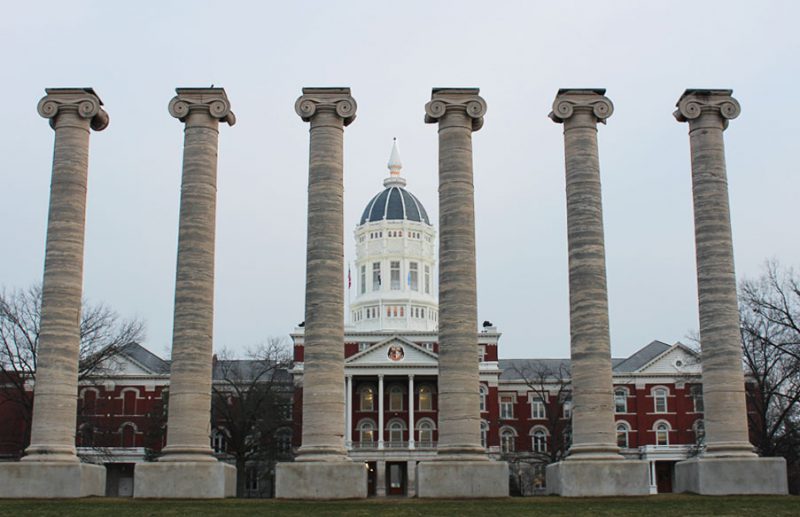[dropcap color=”#000000″ bgcolor=”#” sradius=”0″]A[/dropcap]fter making it past the intersection of a hunger strike, a media firestorm, and an upheaval in leadership, the University of Missouri-Columbia (UMC) is facing an uncertain road ahead.
Today, UMC law school professor Michael Middleton was named Interim President of the university system. His appointment came after a long week of protests and the abrupt resignation of former University of Missouri president Tim Wolfe.
Even with these changes, the issues raised by the #ConcernedStudent1950 movement, which spearheaded many recent student protests, are far from resolved.
“Obviously, as we can see, racism certainly is not over. It is a serious and real situation,” Stephanie Shonekan, an associate professor of Ethnomusicology and chair of the Black Studies department at UMC, said. “Some people might say that it’s not that serious, but from the response from some parts of the population around here, you will understand exactly what the students have been trying to tell us for so long.”
Shonekan was, in part, referring to violent threats made against black UMC students on social media app Yik Yak Tuesday night. Yesterday, University of Missouri police identified Missouri Science and Technology student Hunter Park, 19, as a suspect in the online threats, one of which stated “I’m going to stand my ground tomorrow and shoot every black person I see.” Though the university stated in a press release that there was no immediate threat on campus, many students have expressed fears about safety.
[TS_VCSC_Image_Hotspot_Container hotspot_image=”277735″ hotspot_large=”1366″ hotspot_medium=”1366″][TS_VCSC_Image_Hotspot_Single hotspot_positions=”15,13″ hotspot_color_dot=”#1e73be” hotspot_color_circle=”#2bb673″ hotspot_color_pulse=”#1e73be” content_tooltip_title=”Swastika etched on a stairwell wall in Mark Twain hall” content_tooltip_content_html=”T24lMjBBcHIuJTIwOSUyQyUyMFVuaXZlcnNpdHklMjBvZiUyME1pc3NvdXJpJTIwc3RhZmYlMjBmb3VuZCUyMGElMjBzd2FzdGlrYSUyQyUyMGFsb25nJTIwd2l0aCUyMHRoZSUyMHdvcmQlMjBoZWlsJTIwYW5kJTIwdHJpYW5nbGUlMjB3aXRoJTIwYW4lMjBleWViYWxsJTIwb24lMjB0b3AlMjBvZiUyMGl0JTJDJTIwd3JpdHRlbiUyMGluJTIwY2hhcmNvYWwlMjBpbiUyME1hcmslMjBUd2FpbiUyMHJlc2lkZW5jZSUyMGhhbGwuJTIwQWZ0ZXIlMjBzdGFmZiUyMGNsZWFuZWQlMjB0aGUlMjBzeW1ib2wlMjBvZiUyMHRoZSUyMHdhbGwlMjBhbmQlMjBmaWxlZCUyMGElMjBtYW5kYXRvcnklMjBiaWFzJTIwcmVwb3J0JTJDJTIwdGhleSUyMGZvdW5kJTIwbW9yZSUyMGFudGktc2VtYW50aWMlMjB3cml0aW5ncyUyMGluJTIwdGhlJTIwc2FtZSUyMHJlc2lkZW5jZSUyMGhhbGwuJTIwJTIw” content_tooltip_position=”ts-simptip-position-bottom”][TS_VCSC_Image_Hotspot_Single hotspot_positions=”40,22″ hotspot_color_dot=”#1e73be” hotspot_color_circle=”#2bb673″ hotspot_color_pulse=”#1e73be” content_tooltip_title=”Legion of Black Collegians are called the n-word” content_tooltip_content_html=”VGhlJTIwZ3JvdXAlMjB3YXMlMjBwcmFjdGljaW5nJTIwZm9yJTIwYW4lMjB1cGNvbWluZyUyMHBlcmZvcm1hbmNlJTIwYXQlMjBUcmFkaXRpb25zJTIwUGxhemElMjB3aGVuJTIwYSUyMG1hbiUyMGludGVycnVwdGVkJTIwdGhlaXIlMjByZWhlYXJzYWwlMjBieSUyMGxvdWRseSUyMHRhbGtpbmclMjBvbiUyMGhpcyUyMGNlbGxwaG9uZS4lMjBIZSUyMHJlZnVzZWQlMjBtYW55JTIwdGltZXMlMjB0byUyMGxlYXZlJTIwdGhlJTIwYXJlYSUyMGFuZCUyMHdoZW4lMjBoZSUyMGRpZCUyMGZpbmFsbHklMjBsZWF2ZSUyQyUyMGhlJTIwY2FsbGVkJTIwdGhlJTIwc3R1ZGVudHMlMjBhJTIwc2xldyUyMG9mJTIwcmFjaWFsJTIwc2x1cnMuJTIw”][TS_VCSC_Image_Hotspot_Single hotspot_positions=”58,44″ hotspot_color_dot=”#1e73be” hotspot_color_circle=”#2bb673″ hotspot_color_pulse=”#1e73be” content_tooltip_title=”Man in the back of a truck calls MSA president Payton Head the n-word” content_tooltip_content_html=”UHJlc2lkZW50JTIwb2YlMjBNaXNzb3VyaSUyMFN0dWRlbnRzJTIwQXNzb2NpYXRpb24lMjBzZW5pb3IlMjBQYXl0b24lMjBIZWFkJTIwd2FzJTIwd2Fsa2luZyUyMG9uJTIwSGl0dCUyMFN0LiUyMHdoZW4lMjBhJTIwbWFuJTIwaW4lMjB0aGUlMjBiYWNrJTIwb2YlMjBhJTIwdHJ1Y2slMjBkcm92ZSUyMGJ5JTIwaGltJTIwYW5kJTIwcmVwZWF0ZWRseSUyMHNob3V0ZWQlMjB0aGUlMjBuLXdvcmQlMjBhdCUyMGhpbS4lMjBIZSUyMHBvc3RlZCUyMHRoaXMlMjBleHBlcmllbmNlJTIwb24lMjBGYWNlYm9vayUyMGFuZCUyMG1hbnklMjBzdHVkZW50cyUyMHNlZW1lZCUyMHRvJTIwcmVzb25hdGUlMkMlMjBjbGFpbWluZyUyMG1hbnklMjBzaW1pbGFyJTIwYWNjaWRlbnRzJTIwaGFkJTIwaGFwcGVuZWQlMjB0byUyMHRoZW0uJTIwQ29uY2VybmVkJTIwU3R1ZGVudCUyMDE5NTAlMjB3YXMlMjBhbmdlcmVkJTIwYXQlMjB0aGUlMjBzY2hvb2wlMjdzJTIwbGFjayUyMG9mJTIwYSUyMHJlc3BvbnNlJTIwdG8lMjBIZWFkJTI3cyUyMHBvc3QuJTIw”][TS_VCSC_Image_Hotspot_Single hotspot_positions=”70,94″ hotspot_color_dot=”#1e73be” hotspot_color_circle=”#2bb673″ hotspot_color_pulse=”#1e73be” content_tooltip_title=”Human feces is smeared in the bathroom of Gateway hall in the shape of a swastika ” content_tooltip_content_html=”T25seSUyMGElMjBmZXclMjBkYXlzJTIwYWZ0ZXIlMjBDb25jZXJuZWQlMjBTdHVkZW50JTIwMTk1MCUyMGlzc3VlcyUyMGElMjBsZXR0ZXIlMjB3aXRoJTIwZWlnaHQlMjBkZW1hbmRzJTJDJTIwaW5jbHVkaW5nJTIwdGhlJTIwcmVtb3ZhbCUyMG9mJTIwV29sZmUlMjBmcm9tJTIwb2ZmaWNlJTJDJTIwYSUyMHN3YXN0aWthJTIwbWFkZSUyMG91dCUyMG9mJTIwaHVtYW4lMjBmZWNlcyUyMGFwcGVhcnMlMjBpbiUyMHRoZSUyMGJhdGhyb29tJTIwb2YlMjBHYXRld2F5JTIwcmVzaWRlbmNlJTIwaGFsbC4lMjBDYW1wdXMlMjBkZWNsYXJlZCUyMHRoaXMlMjBhJTIwJTIyaGF0ZSUyMGFjdCUyQyUyMiUyMGJ1dCUyMGlzJTIweWV0JTIwdG8lMjBuYW1lJTIwYSUyMGN1bHByaXQuJTIw”][/TS_VCSC_Image_Hotspot_Container]interactive infographic by Abby Kempf“I spent my whole day with students today, mostly with black students, because they were worried and they gathered together,” Shonekan said.
Shonekan is no newcomer to the student movement sweeping the UMC campus. Just a day before Wolfe stepped down, she gained national prominence with a Nov. 8 tweet. The tweet contained an image of the statement she and other faculty members from the Black Studies department had drafted, which proclaimed support for students protesting perceived institutionalized racism. The tweet quickly spread across Twitter and was soon inundated with hundreds of retweets and likes.
“We just wanted to get behind the students, because what they wanted was change. For such a long time, they felt like nobody was listening to them. They felt uncomfortable on campus; Payton [Head] was called the N-word and nobody reached out to him. It was business as usual, without any sense of urgency for what these students were going through,” Shonekan said. “[The protesters] wanted the administration to really understand the implications of the kind of environment our students were facing now.”
Shonekan’s hope for greater administrative awareness seems to be taking hold. In another press release published on the University of Missouri’s Facebook page yesterday, Interim Chancellor Hank Foley, along with Provost Garnett S. Stokes and Interim Vice Chancellor for Inclusion Chuck Henson, promised to provide more learning opportunities and campus events dealing with race.
The university’s emphatic response has still failed to appease everyone, as some students at UMC believe that the #ConcernedStudent1950 group has overemphasized recent instances of racism. Current MU freshman and 2015 RBHS graduate Spencer Linder is one such student who believes racism is not a major problem on campus.
“Obviously race relations are currently worse than normal due to the protests and everything and yes, I’ve seen instances of racism, but not anymore than usual,” Linder said. “Unfortunately, certain individuals just have negative, ignorant attitudes. I don’t believe I’ve ever witnessed systematic oppression as a [UMC] student.”
Linder said that the protesters camping out on the UMC quad and congregating around campus are operating as a mob-like entity. Opposing their mission, he said, carries the risk of being labeled a racist.
“I think it’s been made out that you either support the protests, or you are a racist, and that’s just simply not true,” Linder said. “I’m obviously against racism, but drastic protests like the ones that have taken place will do nothing but worsen already-racist individuals’ attitudes toward black people or minorities as a whole.”
Unlike Linder, RBHS senior Mariah Doze believes racism is, and has always been, a major problem at UMC, as well as at RBHS.
“I think several people are shocked at what seems to be a random eruption of racism. However, this is an issue that has been occurring for a long while, and for the most part peacefully,” Doze said. “I have also definitely experienced [this kind] of ignorance at RBHS. Just the other day, I witnessed a young man proclaim that he doesn’t care about the issue occurring at [UMC] because he is a white male and it doesn’t affect him.”
Though Doze, who is African American, did not previously intend to follow in her older sister’s footsteps and attend MU, her plans are no longer set in stone. The racist incidents and protests that have ignited so much community tension have only strengthened Doze’s resolve.
“This fiasco has actually had the adverse effect on me that people would think,” Doze said. “I might stay because I feel that I have a duty to help make Columbia a more comfortable place for people of color in the future. I would hate to see this progress stop short.”
According to Shonekan, UMC faculty have already taken steps to address the racial concerns brought to light by the student demonstrators
“I think [the Faculty Council] are working on a number of proposals to make sure we do implement some kind of diversity course that all our students take, so every student has to think about what it is like to live in a truly multicultural, multifaceted world,” Shonekan said.In addition to these plans, #ConcernedStudent1950 has maintained a list of demands they feel the university should implement. One of these demands asks for a 10 percent increase in the percentage of black faculty employed by UMC, an action Linder sees as unjust.
“I think [the demands] are totally uncalled for,” Linder said. “The hiring of faculty should have absolutely nothing to do with skin color, but rather how qualified the individual is.”
Regardless of the proposed policies or adjustments, Shonekan will continue to instruct her students as before, with race and ethnicity as prominent discussion topics.
“I just want to keep going as I was going and continue to challenge students to critique the world that they live in,” Shonekan said. “[I want to] make sure people start releasing those old paradigms of hierarchies as they relate to race.”
Throughout this week of division and discomfort, of revolt and relief, Shonekan has retained her teacher spirit. She said she sees all aspects of the experience, both good and bad, as a learning opportunity.
“We have different cultures and that’s a beautiful thing,” Shonekan said. “In every class I teach, I try to emphasize that: to celebrate our varied and diverse cultures as they all come together, whether it’s one state or one nation or one world.”














































































